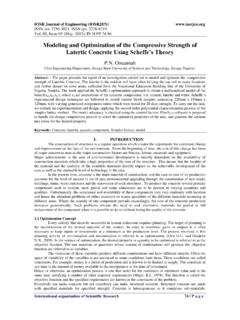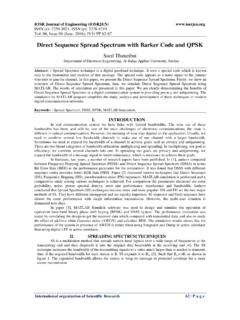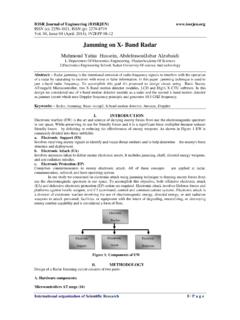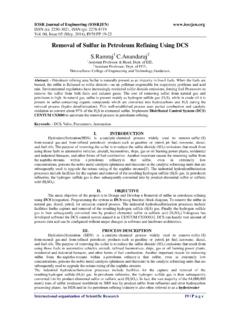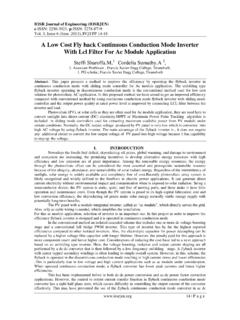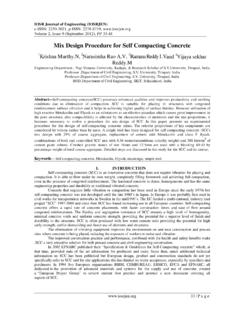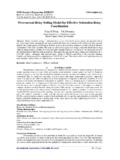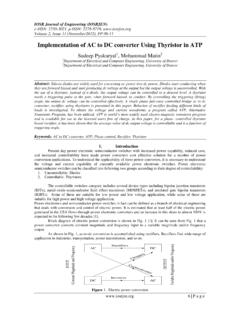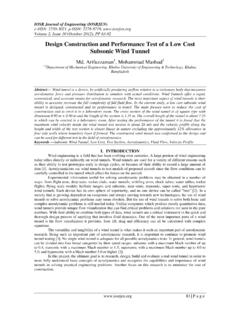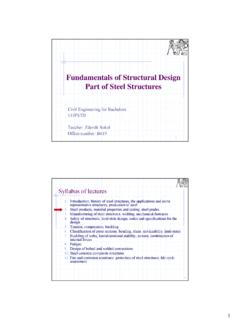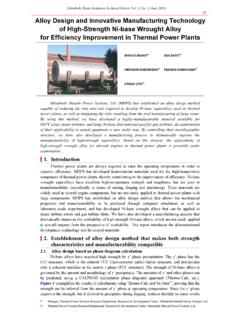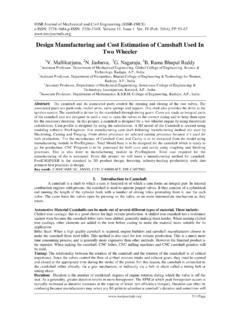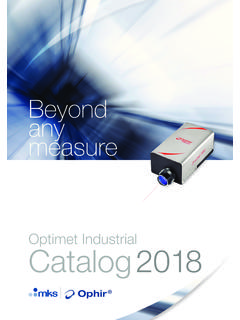Transcription of Minimization of Casting Defects - IOSR-JEN
1 IOSR Journal of Engineering (IOSRJEN) e-ISSN: 2250-3021, p-ISSN: 2278-8719 Vol. 3, Issue 5 (May. 2013), ||V1 || PP 31-38 31 | P a g e Minimization of Casting Defects Achamyeleh A. Kassie1, Samuel B. Assfaw2, 1,2 School of Mechanical and Industrial Engineering Bahirdar University, Bahirdar, Ethiopia, ,, Abstract: In this paper the statistical analysis is aimed to optimize process parameters at the case study, Akaki Basic Metals Industry (ABMI) in Addis Ababa Ethiopia, to minimize major steel Casting Defects . This project is intended to observe just two of the steel Casting Defects which are severe in their nature , gas Defects and shrinkage Defects .
2 In order to minimize these Defects , four process parameters were studied like Sand binder ratio, Mold permeability, Pouring Temperature and De-oxidant amount in three levels. In order to obtain a representative experimental data it was used a factorial The relative influence of each factor on the Casting defect/porosity/ was determined and suggestions have been given using the Statistical Analysis method by optimizing the process parameters. Keywords: Steel Casting , Shrinkage Defects , gas Defects , mold and melting furnace I. INTRODUCTION Casting , one of the oldest manufacturing processes, dates back to when copper arrowheads were made.
3 Metal Casting process considered to be the sixth largest industry in the USA. Casting process basically involve the introduction of a molten metal into a mold cavity, where upon solidification, the metal takes on the shape of the mold cavity. This industry is the major government owned model industry used not only for manufacturing metallic products but also used as a training and research center for all higher education engineering students and other researchers. The main concerns motivating the need for establishing this company was difficulty to find spare parts for old machineries from former suppliers, very long delivery time that required gross orders and huge capital, need to place special orders due to difficulty to obtain regular spare parts, high foreign currency requirement to import the required spare parts.
4 Akaki Basic Metals industry established to make metal melting, forging, machining, heat treatment, automotive maintenance and quality control. It was intended to respond to the need of spare parts for textile, sugar, cement industries, other construction supplies, metal industries, transport sector and to some extent to agriculture, energy and mines sector. The company can cast up to 4,500 tons of metal in two shifts annually. The ferrous foundry can melt nodular iron, grey iron, low carbon and alloyed steels. Among a large number of Casting methods, ABMI utilizes the no-bake sand Casting method for its advantages. There are a number of Casting Defects grouped under different classes.
5 Very few Casting Defects may have no effect on the functionality or service life of Casting products as long as they are within the engineering design specifications and could be easily corrected by any subsequent cleaning or grinding works. The ferrous foundry section in ABMI is experiencing the general imperfections due to voids in most of its steel (46 MnSi4) castings. To some extent, the severity of these Defects may result in a complete rejection of the part there by losing a huge amount of resources spent from product and Casting design to final production. The company uses 46 MnSi4 steel for a varieties of applications such as brake shoe plates, eccentric sleeves, stud head shafts, ring sprocket mount, trash plates, scraper plates, drive disks, concave spacer bearing housings, motor end shields, right and left hook holders, rollers, different pulleys and gears for a number of its customers that include Metehra Sugar Factory, Muger Cement Enterprise, Hibret Machine Shop, Abijata Soda Enterprise, Gafat Armament, Ziquala Steel Mill etc.
6 The following methods are being used for inspecting the Casting Defects . Process inspection, Visual inspection, Chemical composition inspection, Pressure testing, Radiography, Magnetic particle or magna flux testing, Penetrate testing, Ultrasonic testing II. LITERATURE REVIEW Under practical circumstances castings, like all metallurgical products, contain voids, inclusions and other imperfections which contribute to normal quality impairment. Such imperfections begin to be regarded as true Defects only when the satisfactory function or appearance of the product is in question. In such cases, the possibility of salvage, if worse, rejection and replacement should be considered.
7 The decision should be based upon not only the defect itself but also upon the significance in relation to the service function of the Casting and the quality and inspection standards being applied. A defect may arise from a single clearly defined cause which enables the remedy to be more specific and straightforward. It may, however, result from a combination of factors, so that the necessary preventive measures are more obscure. All foundry men are familiar with the persistent defect which defies explanation and Minimmization of Casting Defects 32 | P a g e finally disappears without clarification of its original cause.
8 Close control and standardization of all aspects of production technique offers the best protection against such troubles. More specific precautions can be taken in those cases where there is a known susceptibility to a particular defect, whilst the radical approach of design modification may need to be considered in the extreme cases which do not respond to changes in foundry technique. Defects can, above all, be minimized by a clear understanding of their fundamental causes. [1] Due to the wide range of possible factors, reasonable classification of Casting porosity [2] Defects set difficulties. Some scholars classify Casting Defects based upon their morphology.
9 They prefer identifying Defects by direct observation of the defective Casting or from a precise description of the defect, involving only the criteria of shape, appearance, location and dimensions. This classification, they assume to be more logical than one based upon causes since it requires no prior assumptions to be made. Others are more comfortable with the classification based upon the causes or origins of the Defects . As the researcher in this project believes knowing the cause of a defect is a means to arrive at a best solution to get rid of the defect, the system of classification according to the causes will be adopted throughout this paper Therefore, according to this classification, such Defects may be described as follows: a.
10 Gas Defects , and b. Shrinkage Defects due to volume contraction in the liquid state and during solidification. Different scholars have made varieties of researches on possible causes of porosity formation in different families of steel. They have made lots of experiments on different mold making materials, mold-metal interface reactions, atmospheric interactions, pouring temperatures, melt handling functions and other surrounding conditions which probably constitute the sources for gas Defects . Molten metal is highly reactive material which can make every reaction with nearly all of its surroundings. For instance, its reaction with binders used in mold making for no bake systems usually produces decomposed gases in different levels.
